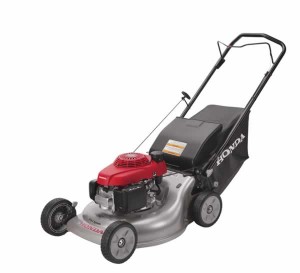 Though they’re among the most durable push mowers on the market, Honda’s mowers do sometimes suffer from a few technical hurdles that need to be resolved before, during, or after mowing. These common problems are usually pretty easy to fix, sometimes with a quick adjustment or a replacement part. Before assuming the worst and calling a local service center for repair services, be sure to review the most common mower problems and the easiest ways to resolve them at home.
Though they’re among the most durable push mowers on the market, Honda’s mowers do sometimes suffer from a few technical hurdles that need to be resolved before, during, or after mowing. These common problems are usually pretty easy to fix, sometimes with a quick adjustment or a replacement part. Before assuming the worst and calling a local service center for repair services, be sure to review the most common mower problems and the easiest ways to resolve them at home.
Safety Disclaimer: Pay Careful Attention When Troubleshooting the Mower
It’s generally a good idea to keep problems limited to the mower, and not take on other problems related to personal injury during troubleshooting. To avoid the risk of injury, make sure to troubleshoot the mower only after its engine has cooled off from recent use. Perform troubleshooting away from pets and bystanders, in a ventilated area with an even, hard surface. Disconnect the spark plug to guard against sparking and unwanted engine activity, and follow procedures exactly as described in the Honda HRR216 operator’s manual as the problem is diagnosed and the issue is fixed.
A Quick Look at the Most Common HRR216 Push Mower Issues
It’s not uncommon for push mowers of all kinds to occasionally show signs of wear that may lead to engine and mowing difficulties. The most common problems each have pretty easy resolutions, many of which take only a few minutes to enact. Consider these common problems and solutions before resorting to authorized service center repairs.
1. The Engine Simply Won’t Start
When the engine refuses to start, the most common cause is almost always that it simply lacks access to fuel, or to fresh fuel that runs efficiently in a push mower of this size. Open the fuel tank and make sure that fuel is present. If it’s not, add unleaded gasoline until the fuel tank is full. If fuel is already present, it’s likely that it has gone stale after an extended period of storage. This can be solved by adding fuel stabilizer to the mix or simply draining the fuel and replacing it with fresh gasoline.
If fuel freshness or fullness is not the problem, double-check that the fuel valve is on, make sure that the spark plug is properly gapped and installed, and make sure that the spark plug wasn’t dampened by a flooded engine. These issues can all be solved at home. Professional service may be required, however, if the engine’s issues are due to a clogged fuel filter, a damaged carburetor, or problems with the fuel valves and ignition process.
2. Loss of Power
A loss of power during cutting is most often due to an empty fuel tank or a clog within the cutting deck. With the mower still powered off, check fuel levels and refill if necessary. Next, tip the mower back and look for clogged grass or debris that might be lodged among the blades. Remove any residual clippings or debris, and try using the mower again. In the future, avoid mowing over debris and only cut the grass if it’s dry. This will discourage clogging.
Other problems that might cause power problems include a clogged air filter, which can be resolved by simply cleaning the part. If the problem is due to carburetor, ignition, or valve problems, professional service will be required.
3. Vibration
Excessive vibration levels typically occur when a clog is present under the deck, and they’re usually noticeable immediately before the mower loses power as a result of the clog. Turn off the mower, tip it back, and clear any clog from the blades. Restart the mower and try again. If this does not resolve the issue, it’s time to inspect the blades and make sure that they’re properly tightened, balanced, and free of damage. If the vibration is due to a bent crankshaft or other mechanical issues, professional service will be required to resolve the problem.
4. Mowing and Bagging Problems
If bagging and mowing aren’t working very efficiently, the problem is likely due to the grass itself. Wet grass, or grass that is excessively long, can be hard to handle when cutting and storing in the included bag. Other issues that might prevent efficient mowing and bagging include a clogged mower deck, warped or dull mower blades, an overfilled clipping bag, or the use of incorrect mower blades in conjunction with the HR216 cutting deck.
Get Ahead of Common Problems with OEM Parts from HondaLawnParts.com
Troubleshooting almost always involves a quick adjustment or replacement of a used part. For the best selection of OEM parts for the HRR216 mower, visit HondaLawnParts.com and take advantage of the parts lookup tool featured on the site. Using drop-down filter boxes, mower owners can find the parts they need based on their engine model number, equipment model number or the part number in need of replacement. It’s a very easy way to take care of the most common mower problems facing HRR216 equipment owners.
